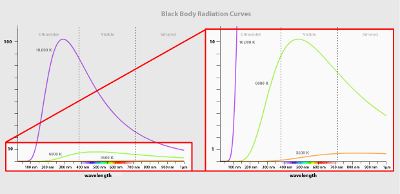Blackbody radiation
What is thermal – or black body – radiation?
Every object with a temperature above absolute zero (that corresponds to 0 K, or -273 degrees C) emits electromagnetic (EM) radiation over virtually all wavelengths. This results from the tiny random motions of particles, atoms and molecules, in the object, which can be described by a thermal energy and thus define the object’s temperature.
The amount of radiation emitted at each wavelength depends only on the object's temperature and not on any other property of the object, such as its chemical composition. This was described mathematically by German physicist Max Planck in 1900. Scientists usually refer to this as thermal radiation. Alternatively, they also use the term 'black body' radiation — a black body is a theoretical object that completely absorbs all of the light that it receives and reflects none. A black body also is a perfect emitter of light over all wavelengths, but there is one wavelength at which its emission of radiation has its maximum intensity.
Hotter objects emit more radiation than colder objects over all wavelengths. Furthermore, the hotter an object, the shorter the wavelength of its peak emission (see figure 1). Recalling that short wavelengths correspond to higher energies, this means that hotter objects give off more high-energy radiation than colder objects—as intuition might suggest.
 |
|
Figure 1: Graph showing black body radiation as a function of wavelength and temperature.Credit: ESA / AOES Medialab |
Temperature and wavelength
Astronomers consider stars to be approximate black bodies that are capable of absorbing light at every wavelength without any reflection. For example, the hottest among stars, with surface temperatures of 10,000 K or more, will emit most of their radiation at ultraviolet (UV) wavelengths. In contrast, stars like the Sun, which are approximately 6000 K at the surface, emit most of their radiation at visible wavelengths, and even cooler stars emit most in the infrared (IR) range. Nearly all of the objects we encounter in our daily lives, including ourselves, are also ‘cold’ and thus emit in the IR range – which is, for example, how humans can be detected with infrared cameras.
The temperature (T, in K) of an object and the wavelength at which it emits most radiation (λ_max, in m) are related in the following way: λ_max T = 2.898 x10^-3 m K. This is usually referred to as Wien’s Displacement law, after the German physicist Wilhelm Wien who discovered it.
Black body radiation in astronomy
This relation is particularly useful to astronomers as it allows them to infer the temperature of stars and other cosmic objects, which lie at enormous distances from us, by simply measuring the 'colour' of their light —more precisely, by measuring the wavelength at which their emission is most intense. Estimating the temperature of stars, interstellar gas and other astronomical sources is crucial to a better understanding of the physical processes that take place therein.
In fact, all objects and astronomical sources are only approximate black bodies. Astronomers have discovered that an almost perfect black body is represented by the Cosmic Microwave Background (CMB), the relic radiation from the Big Bang which pervades the entire Universe. This radiation is the first light ever emitted in cosmic history. When it was released, just 400,000 years after the Big Bang, its energy was enormous, but as the Universe expanded, it cooled and its photons have stretched to increasingly longer wavelengths. At the present epoch, the Universe has an age of ~13.7 billion years, and the temperature of the CMB has become as low as ~2.7 K, slightly above absolute zero. As Wien's law predicts, it peaks at wavelengths just over 1 mm, in the microwave range of the EM spectrum.
Beyond black body: non-thermal radiation
Under certain conditions, the relations described by Planck and Wien about thermal, or black body radiation no longer hold – for example, at temperatures over 10 million K or where very strong magnetic fields are at play. This may happen in a variety of cosmic environments, including the solar corona, the remnants of supernova explosions, neutron stars or the diffuse interstellar gas that pervades the Milky Way and other galaxies.
In these environments, charged particles such as electrons can be accelerated to extremely high speeds, very close to the speed of light, and emit radiation when deflected by a magnetic field or by the presence of protons and other positive ions. In these cases, the amount of energy emitted at each wavelength depends not only on the temperature, but also on the velocities and other properties of the particles responsible for the emission. Thus scientists call it non-thermal radiation. In contrast to thermal, or black-body radiation, non-thermal radiation is not characterised by any peak wavelength. It has an important role for astronomical observations at short wavelengths (X- and gamma-rays) as well as very long wavelengths (radio waves).

